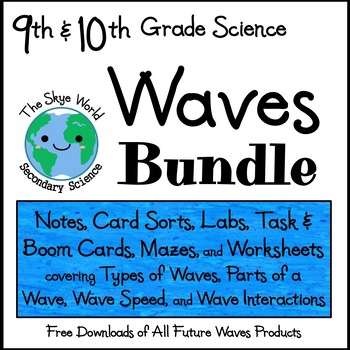Bundle of Lessons - Waves - Notes, Card Sorts, Problems, Labs, and More!
- Zip
- Easel Activity
Products in this Bundle (12)
showing 1-5 of 12 products
Also included in
- This growing bundle covering a year of curriculum for 9th and 10th grade physical science (integrated physics and chemistry) includes the bundles of activities listed below. All lessons are aligned to the TEKS (Texas Knowledge and Skills). Bundles include notes, worksheets, card sorts, task cards,Price $274.00Original Price $420.00Save $146.00
Description
This bundle of lessons will prepare your 9thgrade physical science students to identify and describe longitudinal and transverse waves by properties including amplitude, wavelength, and frequency. Students will learn how to calculate wave speed problems using the variables velocity, frequency, and wavelength. Students will also compare 4 types of wave interaction including reflection, refraction, diffraction, and interference.
Important Information
- Answer keys included
- Recommended for 9th grade science, physical science, IPC (Texas), and algebra-based conceptual physics
Included in this bundle – click to see details
- Notes – Waves
- Card Sort Activity – Wave Vocabulary
- Properties of Waves Worksheet
- Wave Speed Problems Worksheet
- Lab Activity – Relating Pitch and Frequency
- Cart Sort Activity – Classifying Waves
- Cart Sort Activity – The Electromagnetic Spectrum
- Lab Activity – Defining Images with Lenses
- Waves Task Cards with Online Interactive Boom Cards
- Electromagnetic Spectrum Task Cards with Online Interactive Boom Cards
- 4 Wave Mazes - Properties of Waves + Wave Speed Problems Activities
- Reflection and Refraction Worksheet - PDF and Digital Versions
TEKS Covered
I.5G
8.8C
NGSS Standards Covered
MS-PS4-1
MS-PS4-2
HS-PS4-1
HS-PS4-2
HS-PS4-3
Related Resources
- Physical Science Bundle - 9th & 10th Grade Physical Science Curriculum
- Bundle of Lessons – Physics Problems Worksheets
- Bundle of Lesson – Motion – Speed, Acceleration, and Momentum
- Bundle of Lessons – Physics Card Sort Activities
Terms of Use – copyright ©Catherine Skye All rights to this product are reserved by author. This authorizes one teacher to use this product. If you want to share it with other teachers, please purchase a license to share this work. Copying by more than one teacher, classroom, department, school, or school system is prohibited UNLESS you purchase a license. Clipart and elements found in this PDF and others on my site are from the public domain unless otherwise noted. All products on my site are intended for classroom and personal use and may not be digitally copied for reuse in any form. Any misuse is considered copyright infringement and violates the DMCA (Digital Millennium Copyright Act).






